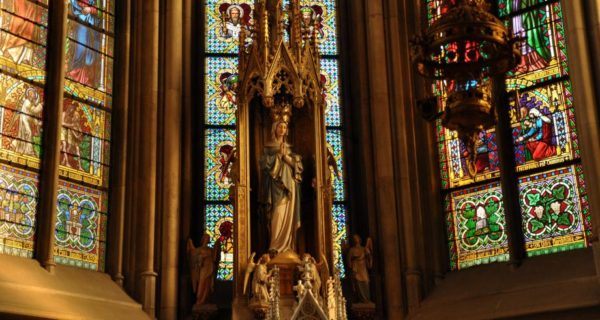The image of Varda as a representation of Saint Mary the Virgin, Jesus’ mother, is clear. As Tolkien asserted, her character was “clearly related to Catholic devotion to [Saint] Mary” (Carpenter, 2006, p. 288), who held a great significance for Tolkien. He called her ‘Our Lady’ and his “perception of beauty both in majesty and simplicity [was] founded” (ibid., p. 172) on her. So, this must have reflected somewhere in his writing. In The Lord of the Rings, Saint Mary was visualized by the character of Galadriel, and in The Silmarillion she is doubtlessly represented by Varda.
This resemblance is evident for several reasons. Firstly, Saint Mary is called the Queen of the World, and Heaven and Varda, the mightiest female Ainu, is similarly called the Queen of Arda. Secondly, Saint Mary is often imagined as the most beautiful human being ever to have lived, because she was born without the original sin. Varda is also said to be of such a beauty that it can hardly be described by any words of any existing language. She is the prototype of beauty and Ilúvatar’s light lives in her face (Tolkien, 1992, p. 16). Likewise, Saint Mary’s beauty is founded by God, Himself, and she bears a symbol of His blessing that illuminates her whole body – something which was further supported by many saints; because whenever she appeared in their visions, she was surrounded by a bright light coming forth from her body.
In a like manner, as Saint Mary is asked for help by Christians, the Elves invoke Varda when they are struggling. They call for her help and care, when they have problems, are afraid, or are going on a long, strenuous journey. An example of this is given in the song which the Elves sing in The Lord of the Rings, where they include some other names given to Varda by their people; very much comparable to the many names which Saint Mary has attributed to her. They call:
“Snow-white! Snow-white! O Lady clear!
O Queen beyond the Western Seas!
O Light to us that wander here
Amid the world of woven trees!
Gilthoniel! O Elbereth!”
(Tolkien, 2011, p. 79)
They later also address her as “the Queen of the Stars, from Mount Everwhite” (ibid., p. 378).
The names Elbereth and Gilthoniel mean “Star-queen” which, in relation with the exclamation “Queen beyond the Western Seas,” is similar to the name of Saint Mary; Stella Maris – “the Star of the Sea,” derived from her function as a guiding star, leading those who wander and are lost back to God and enlightening their journey. As we can see, this is actually noted in the song, too; “Lady clear” refers to Mary’s purity and virginity, and the name “Snow-white” can be related to one epithet which Saint Mary was given after a miracle she performed in Italy.
Legend states that in the middle of summer, she appointed a church to be built from snow, upon a hill in Rome. Consequently, she was named The Lady of the Snow, which was later changed to Santa Maria Maggiore. In visualisations of this miracle, Saint Mary always appears in purely white clothes with pale skin. Similarly, Varda is said to be the fairest – with regards to her colour – and was therefore named “Snow-white.”
Mount Everwhite, is the name of the mountain on which Varda dwelled with Manvë – named for the fact that is it still covered with snow. Thinking about it in connection with the legend, it may well symbolize that miraculous hill in Rome, which Saint Mary selected for her church.
The only difference between Varda and Mary is that while Varda was married to Manvë, Mary was not the wife of Michael the Archangel. Also, the concept of the Ainur getting married is generally dissimilar to Christian doctrines about spiritual creatures. Angels do not marry – they are totally devoted to God and to his love, and they are, of course, genderless. Although Tolkien says that his Ainur were also genderless while they lived within the “Outer Circles,” when they enter the Eä they were given a choice to appear either as male or female forms. Their choice was principally only an expression of “a difference of nature in the ‘spirit’” (Carpenter, 2006, p. 285); or an innate inclination of the spirit. Once they had human bodies, they could, of course, live just as humans do, including getting married, if they so wished.
Resources:
CARPENTER, H. (ed.), The Letters of J.R.R. Tolkien, 2006, London: HarperCollins, 1981. 502 pp. ISBN 978-0-261-10265-1
TOLKIEN, J.R.R., The Silmarillion, 1992, London: HarperCollins, 1992. 480 pp. ISBN 978-0-261-10273-6

